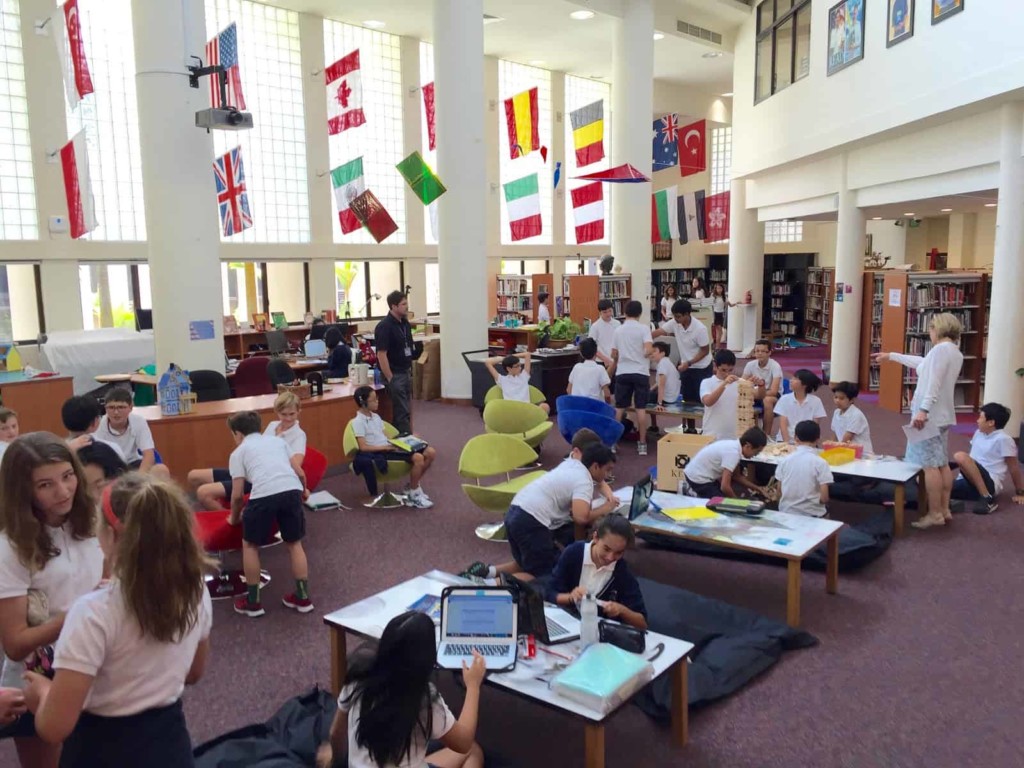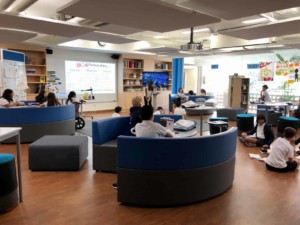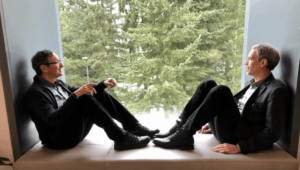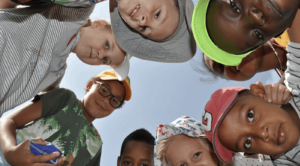20 Signs of Progress at Singapore American School

Successful by traditional measures, the board of Singapore American School asked Dr. Chip Kimball to help make the school as good at life prep as it was at college prep. That launched an extraordinary six-year journey fired by more than 100 school visits and an intense staff study.
Deputy Superintendent Dr. Jennifer Sparrow was Kimball’s partner on the journey. She has deep roots in the community, did her student teaching at SAS and has led the academic program for a decade.
On a recent visit to the 4,000 student school, we saw 20 signs of progress in talent development, care and guidance, and high impact teaching.
Talent Development
1. Clear institutional commitments. Clear goals translate into role clarity. Positional expectations have been updated several times. They inform hiring, development and appraisal.
“We pay attention to talent, teacher and midlevel leadership,” said Kimball. “People often go to the technical aspects of the work but attitudinal is just as important—the willingness to speak truth, take feedback, and learn from failure.”
“You can’t innovate in a culture of fear,” added Kimball.
2. Professional learning communities. For the last 8 years, PLCs have been central to professional learning and improved practice at SAS. They’ve been supported by strengths-based training and facilitated leadership.
3. School visits. Over 100 faculty members visited over 100 schools on six continents. They took lessons back to SAS and discussed them in PLCs.
4. Teacher leadership. About 180 of the 400 faculty have leadership roles. “If PLC is the fulcrum for classroom change than leadership is the fulcrum for school change,” said Kimball.
5. Onsite doctoral program. In partnership with USC, 16 SAS faculty recently graduated with an Ed.D. They received a scholarship for committing to a three year postdoc.
Care and Guidance
6. Elementary SEL. SAS adopted Responsive Classrooms to promote social and emotional learning. “Every adult has been trained how to talk to children,” explained Sparrow. “We stress being safe, responsible, and kind.”
“SEL is part of a culture of excellence, possibilities, extraordinary care.” Added Kimball. “And in our school visits, we found few schools that are exceptional at all three.”
7. RTI. Response to intervention is used K-12. “We’re getting better at answering PLC question three (what if students struggle) and question four (what if students already know),” said Kimball. “You can’t have effective RTI without a PLC,” added Kimball.
8. Pastoral care. To improve both functions, SAS separated college counseling and pastoral care. “College applications are becoming more challenging,” said Kimball, “and we didn’t want to impact college admission process.”
A new student life center (below) has improved social and emotional support and learning.

9. Advisory. A high school advisory period was added and the middle school home-base structure was updated. An advisor works with 8-12 learners with a focus on relationships and pastoral care.
“Every good school we visited had a high functioning advisory system,” said Kimball.
10. Mentoring. With more project-based learning at SAS, Kimball said the focus has shifted from the quality of the final product to the process of learning. That often includes seeking and accessing the help of mentors and serving as a peer mentor–skills that will serve them well in college and beyond. Mentoring is particularly important on the SAS campus where a quarter of the student body turns over annually.
In the upper division, self-directed Catalyst (see #16) projects are a cultural, instructional and course-specific student directed self-study project. For these projects, students are expected to secure and utilize a mentor.
High Impact Instructional Strategies
11. Reggio. Two years ago, the early learning program and space received a Reggio-inspired transformation and it has proven successful and popular.
With Quest, a project-based upper division microschool (see #17), it was a precursor of the change process modeling collaboration, cultural competence and creativity.
12. Language immersion. A primary Chinese language immersion program (below) has been successful and popular and is being extended a grade at a time.

13. Middle-grade projects. Twice a year for six weeks, middle school students have time each day to pursue a passion project during an expanded homeroom period. Teachers received training that included completing their own project. Parents receive frequent communication about the academic intent of the program.
14. Inquiry-based learning. Students are encouraged to pursue inquiry-based learning across the curriculum with a cycle of question, investigate, create, and reflect. Initially, the process begins with teacher-driven prompts (like readers and writers workshop), then moves to a shared inquiry, and finally personalized inquiry (with individual pacing and product, and some teacher support).
15. Maker libraries. The middle school library features a well-stocked makerspace with tools old and new (check out this video). The high school library is a favorite (air conditioned) hang out space (below) as well as a project lab and makerspace.

16. Catalyst project. Every student is required to conduct a self-directed project of at least a semester in length during their junior or senior year with. They secure and work with a mentor in a relevant field and combine school and work-based learning, aiming at specific goals and developing in key outcome areas (character, collaboration, communication, creativity and innovation, critical thinking, and cultural competence, as well as self-awareness and application).
17. Quest. A project-based microschool (below) is open to juniors and seniors. Units of study focus on interdisciplinary collaborative ventures and often connect students with industries from engineering, IT, and marketing.

18. Advanced courses. SAS offers more than 40 advanced courses including Advanced Placement (AP) and internally developed Advanced Topic (AT) courses. The AT courses, developed by SAS faculty in conjunction with college faculty, are more in-depth than the AP courses they replace. (AT Computational Physics v. AP physics) AT courses are also used to fill gaps in the AP offerings (AT Kinesiology).
In a decision that some parents considered controversial, SAS capped the number of AP courses a student could take at seven. This was done to promote deeper learning and discourage the AP obsession that wasn’t improving college entrance options.
The decision to augment AP with AT courses was taken after speaking with dozens of admissions officers at leading universities. “Admissions officers told us our kids were capable but not interested,” said Kimball. The AT courses promote critical outcomes and make SAS students more distinctive. Many of the AT courses offer college credit from leading universities.
19. Competency. With a grant from a parent, SAS hired three curriculum specialists to work with elementary, middle, and high school teams to develop a competency-based curriculum. A well-developed competency framework has been drafted and will be introduced next year. Standards-based grading is already in place K-8.
20. Model Classrooms. In preparation for rebuilding and remodeling the entire SAS campus, model classroom pods called Pathfinder Spaces were developed to illustrate the future learning environment and to investigate specific options regarding groupings, dividing walls, furniture, lighting and air conditioning systems.
“These flexible learning spaces are different than the open concept of the 1970s,” said Kimball. “The goals, strategies, practices, equipment, and materials are different–teachers are actualizing the four questions of PLC in real time,” added Kimball.
The progress the SAS team has made over the last six years is remarkable. Add SAS to your list of schools worth visiting.
Key Takeaways
[:15] About today’s episode with Tom, Chip Kimball, and Jennifer Sparrow.
[1:10] Tom welcomes Chip and Jennifer to the podcast.
[1:21] Tom’s and Chip’s background together, and why Chip decided to join SAS in 2012.
[2:50] Chip’s progress in shaping SAS’s education and facility.
[5:26] Jennifer’s background as an international educator, and what originally drew her to SAS.
[8:12] Tom highlights some of the remarkable progress at Singapore American School since he last visited (two years ago), such as the talent
agenda.
[11:18] Jennifer’s and Chip’s thoughts on fostering talent and the importance of their institutional commitments.
[14:18] About SAS’s professional learning communities (PLC.)
[15:20] Jennifer speaks about how they continue to support, encourage, and monitor their PLC practices.
[17:05] Chip speaks about some of the investments that they’ve made to strengthen their PLC practices.
[20:44] Tom highlights another sign of remarkable progress at Singapore American School: care and guidance (such as adding more social-emotional programming). Jennifer and Chip speak about their work towards this and the progress they’ve made.
[22:53] Two more signs of remarkable progress at Singapore American School: better response intervention and PLC (What if kids don’t get it? How do we intervene? And if they do get it, how do we accelerate their learning?)
[26:11] Why Chip decided to break the roles of college counseling and pastor of care into two.
[30:27] Jennifer and Chip speak about the next step to the work that starts with responsive classrooms: advisory.
[32:29] A focal point of SAS: mentoring (both for students and from students).
[34:24] Jennifer and Chip talk high impact instructional strategies at SAS.
[37:40] What is “try time” for students in middle school?
[43:23] About SAS’s three tiers of inquiry-based learning.
[45:33] About SAS’s personalized inquiry catalyst graduation requirement.
[47:45] One of SAS’s most ambitious changes: becoming a leading AP factory and then scaling that back by strategically replacing AP courses with more advanced topic courses created by teachers and college faculty.
[52:10] Another academic area SAS is making huge progress in — competency-based learning.
[56:03] About SAS’s new learning spaces on campus.
[1:02:57] Tom congratulates Chip and Jennifer in the progress they’ve made at SAS.
Mentioned in This Episode
Singapore American School
Episode 162: “Personalize Learning and Build Agency by Using the 4 PLC Questions”
Why Flexible Learning Environments
Creating The Future of Learning: Singapore American School
For more, see:
Stay in-the-know with all things EdTech and innovations in learning by signing up to receive the weekly Smart Update. This post includes mentions of a Getting Smart partner. For a full list of partners, affiliate organizations and all other disclosures, please see our Partner page.









Tom Vander Ark
Check out Catalyst website where SAS connected mentors to projects https://www.sascatalyst.net/mentorship
It led to doctoral research that "indicated higher levels of higher order cognitive skill development in students who experienced youth-initiated mentoring, especially in their commitment to learning, positive values, social competence, positive identity, future college planning, future planning with adults, and taking actions on future planning."
SAS Parent
This podcast complete propaganda. (1) Sparrow declaring that all teachers that have left under her watch were because they lacked an ability to work within a team is strongly defamatory and defensive yet consistent with Chip's approach of leading by force (if dont agree with him then leave) (2) Chip suggesting criticism is welcome but not cynicism but to see how Chip yells at parents in open forums on more than a few occasions one might believe perhaps correctly that he simply finds any criticism unwelcome (3) Chip and Sparrow have said for years that they are not experimenting yet nearly this entire podcast you Tom and they Chip and Sparrow congratulation themselves for successfully getting away with experimenting; just think about Tom, you unbashfully declare SAS the most progressive school in the world in trying new things (4) Chip and Sparrow and another admin person L Martin are constantly working to get parents off campus and for parents to not be permitted to hold them to account for changes with actual outcome data; Chip and LM have made it their mission to not allow any parent speak with Board members declaring it grounds for a parent to be expelled for entering the school; LM go to line this past 2 years is to tell parents to 'stay in their lane'; such a warm welcoming place LM is making SAS. I could go on as too can so many parents but most parents are too scared of a culture or retribution reverberating throughout SAS.
Katie Walthall
Way to go SAS! Coming from a progressive school in the States to SAS has allowed me to flurish as an educator and to help students succeed in developing skills for lifelong learning and I'm glad it's being recognized. This endeavor was not done without thorough research and relying on teachers who had experience in PLCs, advisory, integrated classrooms, project based learning, etc. Then leaveraging their know how to implement new AT courses, inquiry based instruction, and even emersive experiences like Quest. SAS provides amazing experiences for teachers, students, and parents to work together to create a community of learners. Parents often work with students as mentors and come in to speak to classes. Many people in various careers see the power of the initiatives SAS has employed to help the students compete and secure employment, and also find where their interests lie. But SAS didn't stop there- they then give students an opportunity to pursue their interest for credit and as a bonus differentiate themselves in college apps. It's a win win. So proud of all SAS has done to make a difference in the lives of its students.
Sheree Morgan
We have been at SAS four years and LOVE the school! There are so many incredible opportunities to be had by both students and parents. My friends and I volunteer so much at the school that we joke SAS is our 2nd home in Singapore. Our kids are happy, challenged and proud to be Eagles. From the people who keep the school clean and safe all the way through to the staff in varying locations throughout the campus, people are kind and generous. My Senior is working on his catalyst project this semester. He began contemplating ideas for it beginning Spring semester of his junior year. I laughed when he casually decided he was "just gonna write a book," because I have been thinking about doing that very thing for years but haven't had the know-how to make it happen. The kids here know that if they can dream it, SAS will help them accomplish it. Amazing.
Erica Hansen
As a teacher at SAS for the past five years, I can say firsthand that it has been an exciting and rewarding experience. The changes described in this episode have been a result of both thoughtful, purposeful leadership and collaboration on PLC teams throughout the school. Based on the research done by our R&D teams and adapting what we learned to fit our specific school environment, students are receiving a unique experience/education that is preparing them for their future. I'm proud to be a part of SAS because as a community - students, parents, and educators - we never stop growing and developing.
MS teacher at SAS
It's great to see a light shining in the hard work we are doing at SAS. Hearing about the progressive and future-thinking practices at the school is one of the reasons I decided to join the team from an already situation at a previous school. As part of a Pathfinder (in my second year at the school!), I get to use my almost 20 years of experience in new and more flexible ways. I have a voice in the curricular planning and implementation, and get to collaborate with the other subject teachers on my team almost the entire day. It's hard work, but feels like good work. Students have more voice and choice in their learning, and our flexible walls allow us to vary the classroom size according to need. This is the most challenging yet most rewarding teaching experience I've had so far. Keep moving forward, SAS!
Louise E. Donaghey
As one of the newly appointed curriculum specialists, it has been exciting to work on the development of a competency-based curriculum framework for SAS. I am incredibly grateful that we can engage in this work because of the generosity and vision of a parent donor. We look forward to the learning ahead as we share our work with the SAS community!
MS Teacher @ SAS
Thank you for recognizing the exciting work happening at SAS. It is invigorating to use my 18 years of experience in new and flexible ways. I have a voice in the curricular planning and implementation, and I get to regularly collaborate with other subject teachers to meet the diverse needs of our students. Students have more voice and choice in their learning. This is the most rewarding teaching experience I’ve had so far. Keep moving forward, SAS!